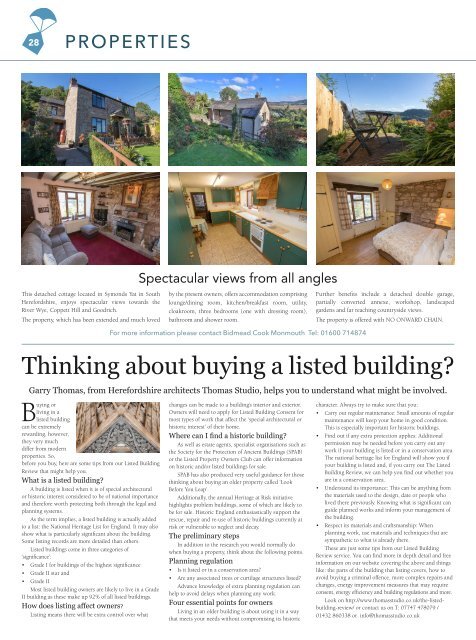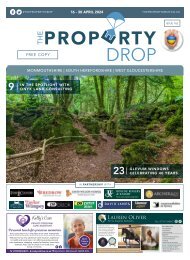Property Drop Issue 16
You also want an ePaper? Increase the reach of your titles
YUMPU automatically turns print PDFs into web optimized ePapers that Google loves.
28<br />
PROPERTIES<br />
Spectacular views from all angles<br />
This detached cottage located in Symonds Yat in South<br />
Herefordshire, enjoys spectacular views towards the<br />
River Wye, Coppett Hill and Goodrich.<br />
The property, which has been extended and much loved<br />
by the present owners, offers accommodation comprising<br />
lounge/dining room, kitchen/breakfast room, utility,<br />
cloakroom, three bedrooms (one with dressing room),<br />
bathroom and shower room.<br />
Further benefits include a detached double garage,<br />
partially converted annexe, workshop, landscaped<br />
gardens and far reaching countryside views.<br />
The property is offered with NO ONWARD CHAIN.<br />
For more information please contact Bidmead Cook Monmouth Tel: 0<strong>16</strong>00 714874<br />
Thinking about buying a listed building?<br />
Garry Thomas, from Herefordshire architects Thomas Studio, helps you to understand what might be involved.<br />
Buying or<br />
living in a<br />
listed building<br />
can be extremely<br />
rewarding, however,<br />
they very much<br />
differ from modern<br />
properties. So,<br />
before you buy, here are some tips from our Listed Building<br />
Review that might help you.<br />
What is a listed building?<br />
A building is listed when it is of special architectural<br />
or historic interest considered to be of national importance<br />
and therefore worth protecting both through the legal and<br />
planning systems.<br />
As the term implies, a listed building is actually added<br />
to a list: the National Heritage List for England. It may also<br />
show what is particularly significant about the building.<br />
Some listing records are more detailed than others.<br />
Listed buildings come in three categories of<br />
‘significance’:<br />
• Grade I for buildings of the highest significance<br />
• Grade II star and<br />
• Grade II<br />
Most listed building owners are likely to live in a Grade<br />
II building as these make up 92% of all listed buildings.<br />
How does listing affect owners?<br />
Listing means there will be extra control over what<br />
changes can be made to a building’s interior and exterior.<br />
Owners will need to apply for Listed Building Consent for<br />
most types of work that affect the ‘special architectural or<br />
historic interest’ of their home.<br />
Where can I find a historic building?<br />
As well as estate agents, specialist organisations such as<br />
the Society for the Protection of Ancient Buildings (SPAB)<br />
or the Listed <strong>Property</strong> Owners Club can offer information<br />
on historic and/or listed buildings for sale.<br />
SPAB has also produced very useful guidance for those<br />
thinking about buying an older property called ‘Look<br />
Before You Leap’.<br />
Additionally, the annual Heritage at Risk initiative<br />
highlights problem buildings, some of which are likely to<br />
be for sale. Historic England enthusiastically support the<br />
rescue, repair and re-use of historic buildings currently at<br />
risk or vulnerable to neglect and decay.<br />
The preliminary steps<br />
In addition to the research you would normally do<br />
when buying a property, think about the following points.<br />
Planning regulation<br />
• Is it listed or in a conservation area?<br />
• Are any associated trees or curtilage structures listed?<br />
Advance knowledge of extra planning regulation can<br />
help to avoid delays when planning any work.<br />
Four essential points for owners<br />
Living in an older building is about using it in a way<br />
that meets your needs without compromising its historic<br />
character. Always try to make sure that you:<br />
• Carry out regular maintenance: Small amounts of regular<br />
maintenance will keep your home in good condition.<br />
This is especially important for historic buildings.<br />
• Find out if any extra protection applies: Additional<br />
permission may be needed before you carry out any<br />
work if your building is listed or in a conservation area.<br />
The national heritage list for England will show you if<br />
your building is listed and, if you carry out The Listed<br />
Building Review, we can help you find out whether you<br />
are in a conservation area.<br />
• Understand its importance: This can be anything from<br />
the materials used to the design, date or people who<br />
lived there previously. Knowing what is significant can<br />
guide planned works and inform your management of<br />
the building.<br />
• Respect its materials and craftsmanship: When<br />
planning work, use materials and techniques that are<br />
sympathetic to what is already there.<br />
These are just some tips from our Listed Building<br />
Review service. You can find more in depth detail and free<br />
information on our website covering the above and things<br />
like: the parts of the building that listing covers, how to<br />
avoid buying a criminal offence, more complex repairs and<br />
changes, energy improvement measures that may require<br />
consent, energy efficiency and building regulations and more.<br />
Look on http://www.thomasstudio.co.uk/the-listedbuilding-review/<br />
or contact us on T: 07747 478079 /<br />
01432 860338 or info@thomasstudio.co.uk


















